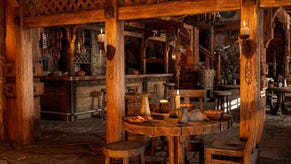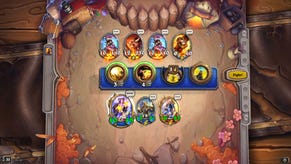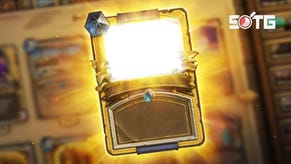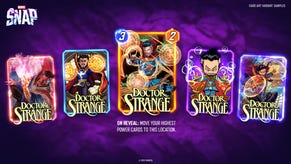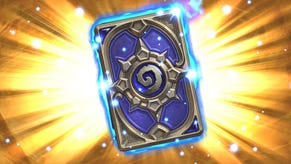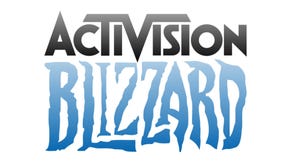Job done! A weekend with the Hearthstone: Heroes of Warcraft beta
After the MMO comes the F2P CCG.
It's hardly a shock to hear that Hearthstone: Heroes of Warcraft will put you in mind of Magic: The Gathering, but perhaps more surprising is the sheer extent to which it will make you think about PopCap games, too. Blizzard's latest is virtual card battling at its most physical and also its most ingratiating.
Cards don't snap when you deploy them - they slam onto the tabletop, venting particle effects and ominous wheezes. New packs glow and then bust open when purchased from the in-game store, and enemy heroes explode in slow motion, scattering fragments across the screen when defeated. You can mess around with the 3D churches and taverns and virtual pets that sit along the edge of the board, the colour scheme is heavy with purples and deep reds and magical, electric blues, gloriously pulpy Warcraft art is emblazoned over the face of every minion or spell card, and the loading bar even says funny PopCap-type things. Bribing guards. Straightening decks.
It all makes sense, too. This is a very traditional collectible card game at heart, but, throughout the design, elements have been streamlined and complications untangled. Player choice hasn't been reined in so much as redirected - channelled into a swifter, more immediate kind of battler. The kind of battler that will fit in around a few levels of Plants vs Zombies.
As ever, the basics are simple: choose one of nine classes of hero from a range of very familiar archetypes and then head online to play against others. The aim of the game is to defeat your enemy's hero while protecting your own, and you do this by fielding cards that might depict minions, beasts, or spells.
When it comes to playing your cards, Hearthstone opts for a single resource, and it automatically grants you an extra resource point each turn (while also topping up any points that you might have previously spent). In your first turn, both you and your opponent will have one mana point to play with, in other words, in the seventh turn you'll both have seven, and the whole thing caps out at ten.
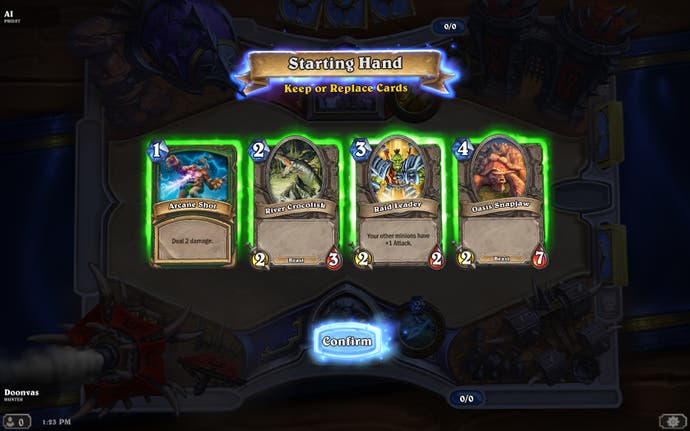
If the automated approach denies players the pleasures of a more involved system that could add an almost StarCraftian element of economy management to proceedings, it's not hard to see why Blizzard's chosen such a trade-off. A single resource set-up that (largely) takes care of itself makes the game much easier to learn, and it focuses your attention onto the main event - the choices that play out as you lay down cards and decide whether to tackle your enemy directly or cripple his minion and beast defences first.
It also provides each game with a rather hectic upwards tick during those first rounds: each new turn sees everyone growing stronger while the cards they can afford to play are deadlier. There's a glorious sense of escalation. Hearthstone games are like magnesium burning - a big, bright conflagration and then it's all over.
The cards themselves suggest that Blizzard's entirely at home with CCGs. There's a touch of Diablo's skills to the way that minions and spells balance strengths with interesting weaknesses. Each minion or beast card comes with two stats, the amount of damage it will do and the amount of health it has (in another concession to speed and immediacy, damage taken is not healed between turns) and beyond that it may have a smattering of additional instructions that will steadily win it a place in your heart.
Battlecries allow cards to deploy basic tricks the moment you first play them - they might grant you two extra cards from your deck, say, heal somebody or deal damage to enemy minions or heroes. Charge cards can attack immediately, rather than waiting it out and snoring for the mandatory single turn - a period where they're sitting ducks for an enemy, meaning that even the really big and dangerous cards can fall in battle before they've had a chance to draw their swords. Taunt cards are the real jerks, though: these cards focus all aggro from the other team - when they're on the board, the enemy can't attack anyone but them. Taunts can really mess up a winning strategy, or they can get you out of a deep pit you've managed to dig for yourself.
Man, some of the cards are pretty special. My favourite card in the early game is the Raid Leader, which does little damage by itself, but will bolster any minions he's stuck alongside. Later on, I'm a huge fan of the Core Hound: Attack 9, Health 5, 7 mana to cast. Check out those stats: they tell you that if you're not careful, you're likely to lose a Hound in that awful fallow round before he awakens. Still, if he does survive, eh? Each enemy hero comes with 30 health, so a Hound or two can really do some damage.
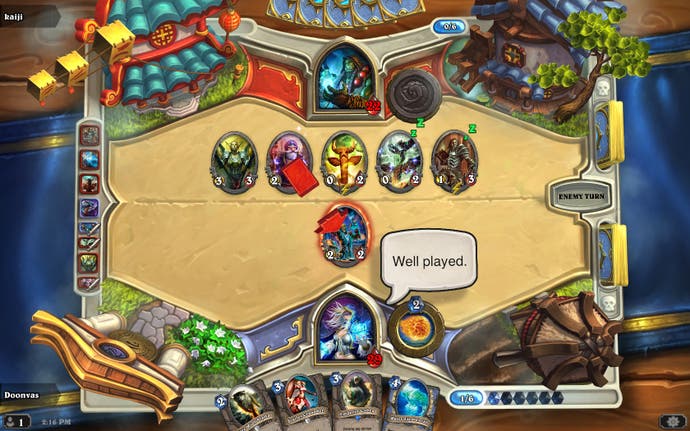
With minions and beasts and spell cards in play, the basic decision, unless there are taunts on the board, comes down to when to focus your attack on the hero themselves, and when to prune the lines of their defences. It's a testament to the early balance of Hearthstone that focusing too much on either approach can lead to defeat. I spent one early game lobbing fireball spells at the enemy hero for a good few turns in the breezy middle act of the encounter. I ignored the range of fairly low-danger minions my foe was building up, and then he dropped in a few cards which tweaked their attack stats by little more than a point or two and I was dead within three turns.
Equally, I've gotten myself in a lot of trouble playing as a shaman, a class that can summon a random buffing totem each turn. I had an impressive defensive field, but there were no taunts on my side, so my rival simply went around my buff-dealing Maginot line while I merrily totemed myself into oblivion. (I've played an awful lot of shamans in online games, incidentally, suggesting that they might be a little overpowered for new players when wielded properly.)
Those heroes are the last part of the deal - each one coming with its own range of core cards that are unlocked as you level them up with wins and losses. At first, there might seem to be a few too many classes to get your head around - unless you've played World of Warcraft, since each hero is based on a classic WOW character class and shares many of its characteristics and even skills. But, just as in the MMO, Blizzard is worryingly good at making them stand apart from each other in obvious ways.
Rogues, for example, have a lot of sneaky back-stabby type attacks, while priests do a good deal of healing - a particular danger when coupled with a card that allows you to draw an additional card with every minion you heal. Each class comes with its own hero skill, which can be played each round if you have enough mana, and they can also attack if they have a weapon equipped. Weapons degrade with use, while those skills of theirs have some real Warcraft blood running through their veins. My favourite is the Warlock, who can cash in some of his own health for an extra card. Cripes, I've made things hard for myself with that guy.
Besides unlocking each class's core cards through regular play, you can also buy cards in packs of five from the in-game shop. Each pack will guarantee at least a single card that's rare or better, and there will generally be a nice mix of cards aimed at specific classes and cards that any class can use. You can buy cards using in-game gold that is won by playing online and completing quests or by beating mini-challenges that often spread over the course of a handful of games. But after a while, the early flood of gold slows to a trickle.
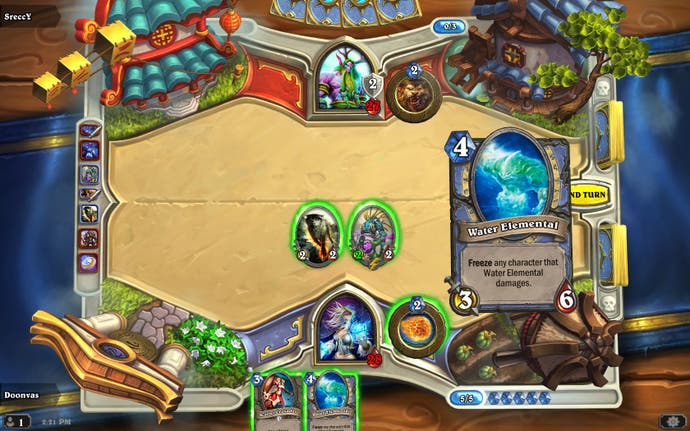
When that happens, you can turn to PayPal, and this is where Blizzard's mastery of interface and feedback may well cost you some money. Set aside the cards themselves: Blizzard makes buying them such a guilty pleasure. The leather pack flips out at you, then starts to glow and vibrate before it busts open. The UI shakes in a magical breeze, and then your five cards are dealt face down and are yours to turn over. Only people who have really thought about how to get your cash understand the power of granting cards face down: five extra jolts of adrenalin.
As for the balance issues attendant in playing against opponents who have bought a lot of cards, that's going to take some time to get to grips with, as it always does with a free-to-play game. My early experiences suggest that Blizzard's too smart to sell cards that are flat-out better versions of early free cards, though: more powerful cards are often different, too. Take the Molten Giant. God, I love the Molten Giant. He's expensive to play and deals a whole lot of damage, but his resource cost comes down as your own hero starts to lose health. He's a quad-barrelled shotgun you can only pull the trigger on when you're dangerously close to death.
The deck-building side of things is going to take longer than a weekend of playing to assess, too. The classes provide a nice starter framework, though, and the interface allows for easy arrangement and naming of custom decks. There's even a card suggestion tool. On top of that, since a lot of Hearthstone's potential audience have never done this stuff before, there's an arena mode, which is available once you've unlocked all the classes by beating them in practice matches. The arena essentially forces you to make a deck - it makes you pick one of three cards, 30 times in a row, very quickly - and then use that deck as you play against other people in mini-tournaments. It costs real money each time you enter the arena - after the very first time, of course - but the longer you last in there, the better the prizes you earn become.
Ultimately, though, the best way to get to grips with decks is to just get stuck into online matches. It's a surprisingly small step from Hearthstone's five-game mini-campaign tutorial to genuine online play - and by that point, you're already learning, already scheming. Hearthstone's so quick to become brilliant fun that I'm almost not sure if it can last. As ever with these things, its future lies in the cards.




